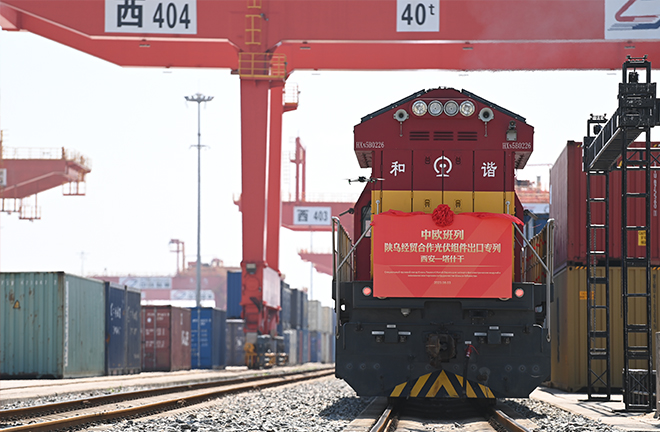BRI projects illustrate China’s commitment to green development

A China-Europe freight train carrying photovoltaic modules departs from Xi’an in northwest China’s Shaanxi Province to Tashkent, capital of Uzbekistan, to advance local new-energy projects. Photo: XINHUA
The year 2023 was the hottest year on record, according to the European Union’s Copernicus Climate Change Service. The increased intensity and severity of droughts, water scarcity, wildfires, rising sea levels, flooding, melting polar ice, catastrophic storms, and declining biodiversity have revealed that climate change is the most pressing issue facing humanity today. Environmental protection and sustainable development have become the paramount focus of our era.
China’s green engagements
At the third Belt and Road Forum for International Cooperation held in October 2023, Chinese President Xi Jinping announced eight major steps China will take to support the joint pursuit of high-quality Belt and Road cooperation, including promoting green development.
In a recent interview with CSST, Jorge Heine, a research professor from the Frederick S. Pardee School of Global Studies at Boston University and former ambassador of Chile to China, said that China’s commitment to green development announced at the third Belt and Road Forum for International Cooperation is much welcomed and has raised expectations. China is at the forefront of green energy technological development, including solar and wind, both in terms of quality and quantity. Additionally, the country is also leading the way in e-mobility. As a result, China emerged as the world’s leading exporter of automobiles in 2023, largely due to its production of new energy vehicles.
Christoph Nedopil, director of the Griffith Asia Institute in Australia and also director of the Green Finance and Development Centre at Fanhai International School of Finance under Fudan University, has published a series of reports analyzing investments made within the Belt and Road Initiative (BRI) framework.
According to the reports, China’s total engagement in green energy (solar and wind) and hydropower amounted to about $4.8 billion in the first half of 2023, as compared to $3.8 billion in the first half of 2022. Construction projects related to green energy (including hydropower) increased from $1.6 billion in the first half of 2022 to $2.6 billion in the first half of 2023. Another area of strategic importance is China’s involvement in metals and mining. Engagement in the sector has grown by 131% compared to the first half of 2022. Minerals and metals are particularly relevant to the green transition and batteries for electric vehicles.
Nedopil told CSST that numerous Chinese policy documents, along with the Traffic Light System (TLS) for BRI projects published by the BRI International Green Development Coalition, highlight the need for green development that encompasses climate, biodiversity, and pollution.
The TLS proposes a measure to classify projects into three categories of “red,” “yellow,” and “green” according to their positive and negative impact on the three environmental dimensions of climate, pollution, and biodiversity.
Holistic approach needed
However, Nedopil argued that for green development, a holistic system of environmental and social risk management must be established. As emphasized in the TLS, green projects entail more than just focusing on a specific sector, such as renewable energy; they also involve the minimization and mitigation of environmental risks, including those related to biodiversity, throughout the entire process of project development and implementation. For instance, the TLS acknowledges the potential negative impacts of hydropower on biodiversity.
Nedopil believes that adherence to international standards will not only reduce environmental risks for Chinese financial institutions and developers, but also allow for more collaborative financing or tripartite cooperation on projects.
Nonetheless, green transformation is a very holistic and complex endeavor touching all sectors and all environmental dimensions, such as pollution, climate aspects, and biodiversity. According to Nepodil, the goal of green development is to ensure that projects improve the environment across all dimensions, or at the very least, minimize environmental impacts as much as possible. For example, green energy projects can contribute to electricity with less greenhouse gas emissions, while it is equally important to reduce greenhouse gas emissions through the repurposing of existing coal plants.
Challenges
At the moment, Nedopil pointed out that an important challenge for green transition lies in the capacity to comprehend and manage environmental risks with developers, financial institutions, and local regulators—factors still considered costly and time-consuming. Another risk pertains to the availability of financial resources for investment in green projects. Additionally, there are challenges associated with vested interests and outdated notions regarding the necessity of developing specific polluting industries, such as coal or gas.
Heine believes that the main challenges now lie in switching from established fossil-fuel powered plants to new, renewable energy sources. The former have long been in use and are considered sunk costs, whereas the latter demand fresh capital and new approaches to power management. Given that the sun does not shine 24/7, and the wind does not blow continuously, addressing these challenges demands the willingness and the capacity to innovate and to think outside the box, something that is not always present, Heine added.
Edited by CHEN MIRONG
